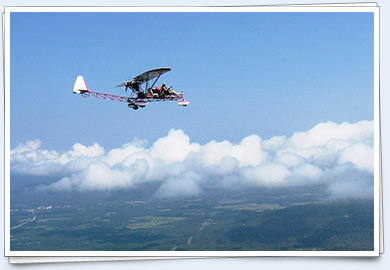| ||||||
| Streaming effects |
| |||||
Training TipsStreaming effects Whatever word you've heard, the air involved in this flow has not finished exerting its varied influences on your aircraft's flight once it has interacted with the prop. From stalls to glides, or the cooling of the aircraft's engine, slipstream effects make their presence known in many ways during flight. A student pilot is most likely to first encounter the term slipstream in ground school, when studying the aerodynamics of slow flight. The so-called spiraling slipstream is one of the forces that create most single-engine airplanes’ left-turning tendency—an effect that is most pronounced during flight at minimum controllable airspeed. The rudder and elevators of many aircraft become "alive" early in the takeoff run because of slipstream effects—but not in T-tail aircraft on which the horizontal surfaces are positioned outside of the propeller slipstream. If a cabin door should pop open after you take off, the slipstream tends to keep it pressed close to the fuselage until you can land and close it again. When a pilot senses a change in aircraft noise after an airspeed adjustment, flap extension, or during a power-off glide, another slipstream effect is making itself known. This perception may occur at an unconscious level, contributing to a pilot's ability to "fly by feel." Slipstream air is harnessed to cool most trainers' engines, but traditional inlets "that extend into the slipstream to 'scoop' the air obviously create considerable parasite drag. NACA (National Advisory Committee for Aeronautics) researchers discovered that turning the scoop inside out so that it is recessed in the engine cowl or airplane structure resulted in a much smaller loss of efficiency," Mark Twombly wrote in the November 2003 Flight Training. Slipstream effects have a lot to do with the contrasting aircraft responses during two kinds of stalls. During power-on stalls, the elevators may stay effective longer if they are within the propeller’s slipstream. That, along with the effects of propeller thrust, explains in part why you may have noticed that power-on stalls may feel more abrupt than power-off stalls. Flight Training NewsSchmelzer joins May Flight Training chatFlight Training Contributing Editor and FAA Designated Pilot Examiner Bob Schmelzer will be a guest on the May Flight Training Facebook chat. Join Schmelzer and the Flight Training editors on Tuesday, May 1, from 3 to 4 p.m. Eastern, and bring all your checkride-related questions and issues. To participate in the chat, log on to the Flight Training Facebook page and click on the chat link. View a transcript of previous chats. Marine double amputee now a sport pilotAble Flight scholarship recipient Adam Kisielewski passed his sport pilot practical test on April 19 with flying colors. The former U.S. Marine, who lost his left arm and part of his right leg in combat in Iraq, has been training at Frederick Municipal Airport in a Flight Design CTLS. Read more >> Do you FlyQ? AOPA’s new app availableYou've asked for it, and now it's here. AOPA now offers members a free, full-function airport information and flight-planning iPhone application. FlyQ features airport information, weather briefings and graphics, a robust flight-planning engine, and the ability to file flight plans. Read more >> Women fly it forwardIt's official: Frederick Municipal Airport, the home airport of AOPA, is the most female-friendly airport in the United States for 2012, thanks to the efforts of local pilots who flew 242 women and girls out of the airport on March 10. Worldwide, pilots carried 1,104 girls and women aloft during Women of Aviation Worldwide Week. Read more >> Free ground school offered at Republic AirportA free 12-week private pilot ground school will begin on June 2 at Republic Airport in Farmingdale, N.Y. The course is hosted by ZJB Flight Instruction Services and will be held at Empire Flight Academy. All subject areas of the FAA private pilot practical test standards pertaining to aeronautical knowledge will be covered. To register, or for more information, contact Zachary Barrett at 516/658-2560 or by email. NH education program gets off the groundAn aviation education program in New Hampshire has ambitious plans for the future. The Aviation & Aerospace Education Center at Winnipesaukee (WinnAero), at Laconia Municipal Airport, aims to offer programs for children while promoting interest in science, technology, engineering, and math through aeronautics and aerospace. A children's aviation museum also is planned. The nonprofit WinnAero was the inspiration of retired attorney Bill Seed, and is supported by Airport Manager Diane Cooper, who also is a director and participates in the organization's programs and events. "The Laconia Airport takes its role in the community very seriously," she said. "Educating the public about aviation is part of the mission of the airport. We want to educate all age groups about aviation and encourage children who are interested in careers in aviation and aerospace to pursue those dreams." For more information about WinnAero, see the website. Training ResourcesFlight service briefers are a great resource to pilots before, during, and after a flight. Whether you want to open a flight plan, check the weather before you depart, or find out just how nasty those clouds ahead of you really are, they can take care of all of that. But there are some finer details you should know about contacting them. Test your knowledge with the Air Safety Institute's Flight Service safety quiz, underwritten by the AOPA Insurance Agency. Take the quiz >>
Did you know that student pilots who join AOPA are three times more likely to complete their flight training? Membership includes unlimited access to aviation information by phone (800/USA-AOPA, weekdays from 8:30 a.m. to 6 p.m. Eastern time) or from Flight Training Online or AOPA Online. If you’re not already a member, join today and get the pilot’s edge. Login information is available online. Boeing 787 Career PilotBoeing marks 4,000th Next-Generation 737More than 500 Boeing employees, executives, suppliers, and government officials joined China Southern Airlines on April 13 to celebrate the 4,000th Next-Generation 737. The 4,000th Next-Generation 737 jetliner off the Renton, Wash., production line was to be delivered to China Southern Airlines, headquartered in Guangzhou, China. The milestone jet is a 737-700 model that seats 126 passengers in a two-class configuration. More 737s have been produced than any other commercial jetliner in history. With more than 5,550 airplanes in service, the 737 family represents more than a quarter of the total worldwide fleet of large commercial jets flying today, according to Boeing. More than 358 airlines in 114 countries fly 737s. Southwest makes pitch for Hobby international serviceSouthwest Airlines on April 9 launched a website to rally support for international service from William P. Hobby Airport in Houston. Earlier this year, the carrier asked the city of Houston for approval to construct a new five-gate international facility at the airport. This proposed expansion—paid for by the users of the facility and guaranteed by Southwest—would open new low-cost international travel competition to the area, creating an economic impact for the city of more than $1.6 billion annually, Southwest said. Houston Director of Aviation Mario Diaz has recommended that the city work with Southwest to expand the federal inspection services facility at Hobby, to support scheduled commercial international service. Plane SpotterGrob 109: Glider with power Training ProductsAPR lighted omni kneeboard from PilotMall.comFor the pilot who wants a kneeboard with extras, APR’s lighted omni kneeboard comes with a light-emitting diode (LED) light that illuminates the board's surface. The board is engineered of aluminum and includes one-inch top and bottom clips to hold flight plans, charts, or an approach plate book. The board is held in place by an adjustable elastic strap. Included in the $119.99 price is a pad of VFR en route flight logs. Order online or call 800/249-5730.
Note: Products listed have not been evaluated by ePilot editors unless otherwise noted. AOPA assumes no responsibility for products or services listed or for claims or actions by manufacturers or vendors. BlogsIt looked easy on paperFull flights, unpleasant weather, a malfunctioning fuel pump, and an 80-knot headwind: All this and more were dished up to professional pilot Chip Wright. Also in this week’s Flight Training blog, Technical Editor Jill Tallman wants to know the shortest runway you've landed on, and introduces you to Sugar Valley Airport, whose student pilots handle 2,424 feet with ease. Weather (and other inconvenient setbacks)Ever have one of those months where everything conspires to keep you on the ground? Student pilot Kristen Seaman knows all about it, but she's found some ways to make the best of it, as she describes in the latest Let’s Go Flying blog. AOPA Career OpportunitiesEver dream of turning your passion for aviation into a career? We’re looking for a manager–Pilot Information Center, vice president–Center to Advance the Pilot Community, aviation technical writer, vice president of strategy and philanthropic operations, program manager–products, project manager of online products, director of new market development, and associate editor–Web/ ePilot. To learn more about other AOPA career opportunities, visit AOPA Online. Community
AVIATION EVENTS & WEATHER
| ||||||||||||||||||||||||||||||||||||




 Your trainer's
Your trainer's 





